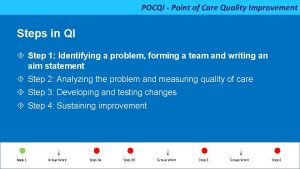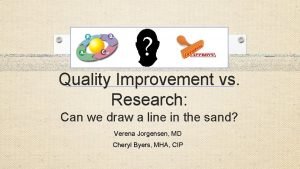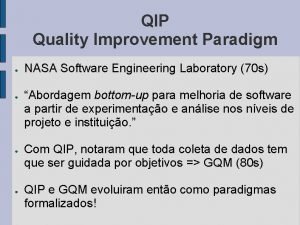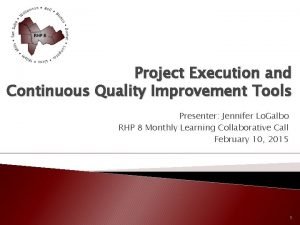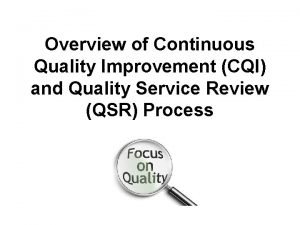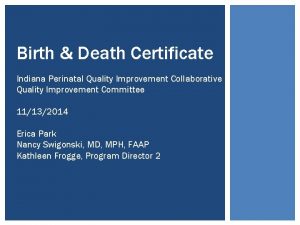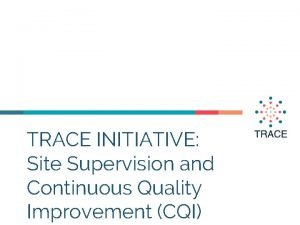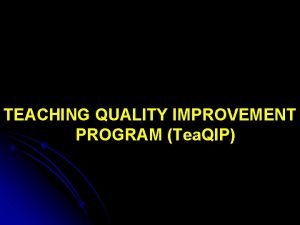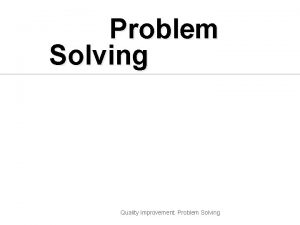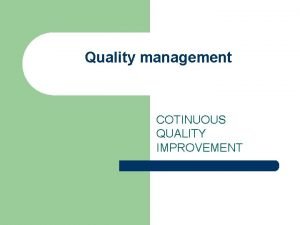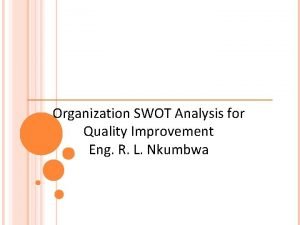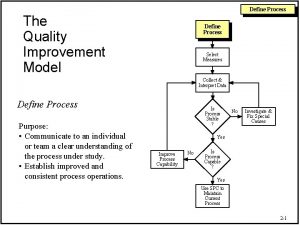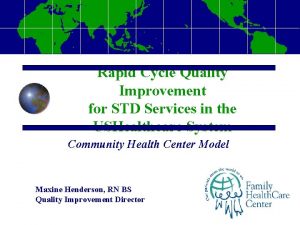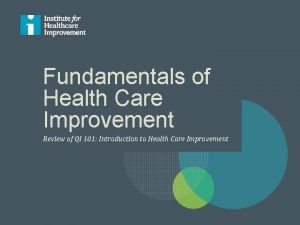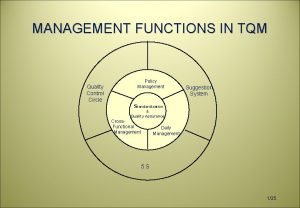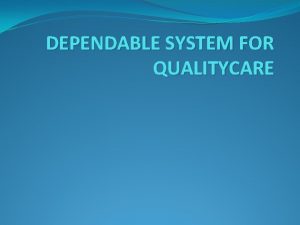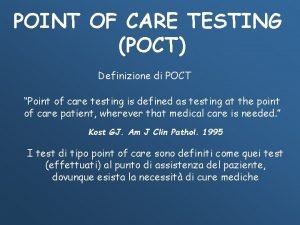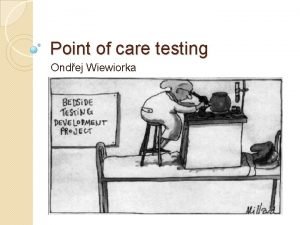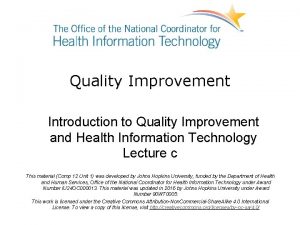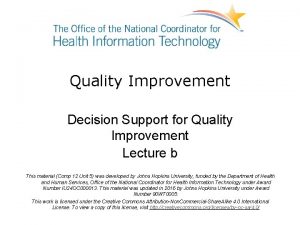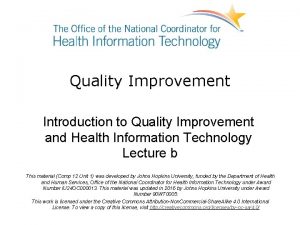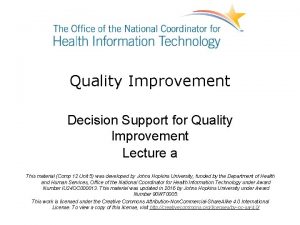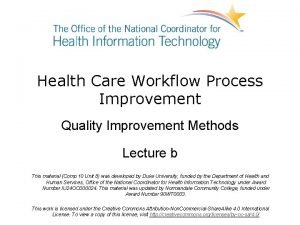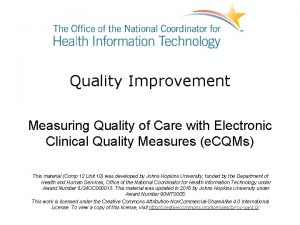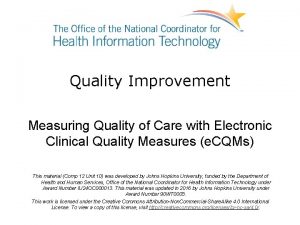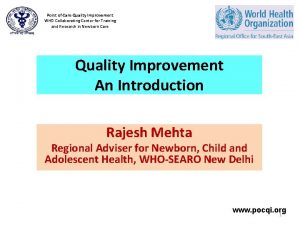POCQI Point of Care Quality Improvement Steps in






























































- Slides: 62

POCQI - Point of Care Quality Improvement Steps in QI Step 1: Identifying a problem, forming a team and writing an aim statement Step 2: Analyzing the problem and measuring quality of care Step 3: Developing and testing changes Step 4: Sustaining improvement Step 1 Group Work Step 2 A Step 2 B v Group Work Step 3 Group Work Step 4

POCQI - Point of Care Quality Improvement Step I : Learning objectives How to review data to identify problems How to prioritize which problems to work on How to form a team to work on that problem How to write a clear ‘aim statement’ Step 1 Group Work Step 2 A Step 2 B v Group Work Step 3 Group Work Step 4

POCQI - Point of Care Quality Improvement Identifying a problem to solve Data-based decision: Review local health facility data and identify gaps related to quality of care Simple, easy to fix & amenable to change Value for patient outcomes Does not need many new resources Short turn-around time: early success is motivating Avoid long-term projects initially Decreasing maternal mortality in a small facility: Decreasing hemorrhagic disease in newborn (vitamin K related): since onset is late follow up after discharge is required to capture this Step 1 Group Work Step 2 A Step 2 B v Group Work Step 3 Group Work Step 4

POCQI - Point of Care Quality Improvement Select your team Look for volunteers who are: Enthusiastic - they want to make changes Involved - they are already doing the work that needs change Influential - others people listen to them and they can get things done Step 1 Group Work Step 2 A Step 2 B v Group Work Step 3 Group Work Step 4

POCQI - Point of Care Quality Improvement Select your team Identify who should be in the team: Ø Need people from every level: from administrators to cleaners Ø From all involved departments Ø Assign some key roles Ø Leader Ø Recorder Ø Communicator Step 1 Group Work Step 2 A Step 2 B v Group Work Step 3 Group Work Step 4

POCQI - Point of Care Quality Improvement Why is teamwork important for improvement ? Healthcare is delivered by a range of people in the hospital Given the opportunity, staff can identify problems and generate ideas to resolve them Participation improves ideas, increases buy-in, and reduces resistance to change Accomplishing things together increases the confidence of each member Step 1 Group Work Step 2 A Step 2 B v Group Work Step 3 Group Work Step 4

POCQI - Point of Care Quality Improvement Aim statement Characteristics of a good aim statement States a clear, specific aim –’what’ are we improving Linked to specific patient population – ‘who’ will be affected Should include a goal – ‘how much’ will we improve Neither too difficult nor too long to achieve Includes a timeline – ‘by when’ will the goal be achieved Step 1 Group Work Step 2 A Step 2 B v Group Work Step 3 Group Work Step 4

POCQI - Point of Care Quality Improvement SMART Aim Specific Measurable Achievable (but challenging) Relevant and recorded Timely Step 1 Group Work Step 2 A Step 2 B v Group Work Step 3 Group Work Step 4

POCQI - Point of Care Quality Improvement Aim statement Problem: All babies are not dried immediately after birth We will increase immediate drying at birth in all 100% of births from current 60% within 4 weeks, from May 1 st to June 1 st. Who (which patients)- Newborn What (the process)- Immediate drying How much (the amount of desired improvement)- from 60% to 100% By when (time over which the improvement will occur)- within 4 weeks Step 1 Group Work Step 2 A Step 2 B v Group Work Step 3 Group Work Step 4

POCQI - Point of Care Quality Improvement Aim statement Problem: Babies are cold at one hour following birth We will reduce the percentage of newborns with low temperature (<36. 5 C ) from current 50% to <10% within 6 weeks, from 15 th June to 30 th July. Who (which patients) - Newborns What (the outcome) - Hypothermia (<36. 5 C) How much (the amount of desired improvement) - from baseline of 50% to <10% By when (time over which improvement will occur)- within 6 weeks Step 1 Group Work Step 2 A Step 2 B v Group Work Step 3 Group Work Step 4

POCQI - Point of Care Quality Improvement Is this a good aim statement To establish skin to skin contact after delivery in low risk mothers admitted in Labour Room To establish skin to skin contact immediately after delivery for at least one hour from 0% to 25% within two weeks for newborns of low risk mothers admitted in Labour Room Step 1 Group Work Step 2 A Step 2 B v Group Work Step 3 Group Work Step 4

POCQI - Point of Care Quality Improvement Step 1 Group Work Step 2 A Step 2 B v Group Work Step 3 Group Work Step 4

POCQI - Point of Care Quality Improvement Steps in QI Step 1: Identifying a problem, forming a team and writing an aim statement Step 2: Analyzing the problem and measuring quality of care Step 3: Developing and testing changes Step 4: Sustaining improvement Step 1 Group Work Step 2 A Step 2 B v Group Work Step 3 Group Work Step 4

POCQI - Point of Care Quality Improvement Step 2 Learning objectives You will learn Ø Tools for understanding processes and systems of healthcare Ø How these tools can help identify possible causes for the problem Ø How to develop indicators for process and outcome Ø How to use indicators to track improvement Step 1 Group Work Step 2 A Step 2 B v Group Work Step 3 Group Work Step 4

POCQI - Point of Care Quality Improvement Step 2: Importance of Analysis Ø Explore in detail possible causes of a problem Ø Helps focus on things that are within our control Ø Gives an opportunity for everyone to give their insights based on their role in the process Ø Helps us understand what is happening in the system at present and thus identify possible solutions Step 1 Group Work Step 2 A Step 2 B v Group Work Step 3 Group Work Step 4

POCQI - Point of Care Quality Improvement Tools for analysis Why might a problem be happening? 1. 2. 3. 4. Step 1 Group Work Fishbone Five Why’s Pareto Principle Process Flowchart Step 2 A Step 2 B v Group Work Step 3 Group Work Step 4

POCQI - Point of Care Quality Improvement 1. Fishbone : Identify all possible contributing factors Why might a problem be happening? People Places Procedures (practices) Policies anything else Step 1 Group Work Step 2 A Step 2 B v Group Work Step 3 Group Work Step 4

POCQI - Point of Care Quality Improvement 1. Fishbone : Identify all possible contributing factors Step 1 Group Work Step 2 A Step 2 B v Group Work Step 3 Group Work Step 4

POCQI - Point of Care Quality Improvement 2. “Five whys” Understanding why something is the way it is Mothers are not breastfeeding – Why? They feel uncomfortable taking their gown off – Why? The gown opens at back, so they have to take entire gown off to breastfeed, so they feel uncomfortable. Why they have this type of a gown? That is what store keeper orders. Why doesn’t the store keeper order better gowns appropriate for breast feeding? Because no one has requested him to do that Step 1 Group Work Step 2 A Step 2 B v Group Work Step 3 Group Work Step 4

POCQI - Point of Care Quality Improvement 2. “Five whys” Understanding why something is the way it is Alternative Scenario Mothers are not breastfeeding – Why? They feel uncomfortable taking their gown off Why ? There is no privacy to breast feed, so they feel exposed. Why is there no privacy to breastfeed? They are in a common ward. There are no curtains or separate covered space for privacy for breastfeeding Step 1 Group Work Step 2 A Step 2 B v Group Work Step 3 Group Work Step 4

POCQI - Point of Care Quality Improvement 3. Pareto Principle 80% of the problem is due to 20% of the couses Step 1 Group Work Step 2 A Step 2 B v Group Work Step 3 Group Work Step 4

POCQI - Point of Care Quality Improvement Pareto Principle Example: Medication error Monitoring not done Wrong Route Wrong Patient Expired Medicine Wrong Dosage Missed Dose Wrong label on vial Dilution Error Improper Storage Prescription Error v 0% Step 1 Group Work Step 2 A 5% 10% 15% 20% 25% 30% 35% 40% 45% 50% Step 2 B v Group Work Step 3 Group Work Step 4

POCQI - Point of Care Quality Improvement Pareto Chart Example: Medication Error 100 80 80 86 93 90 96 98 99 100 65 60 80% of problems due to 30% of causes v 45 40 20 0 Prescription Error Improper Storage Dilution Error Wrong Label Missed Dose Wrong Dose Expired Drug % Step 1 Group Work Step 2 A Step 2 B v Wrong Patient Wrong Route Monitoring not done Cum % Group Work Step 3 Group Work Step 4

POCQI - Point of Care Quality Improvement 4. Process flowchart How to develop a process flow chart 1. Decide the beginning and end points of the process 2. Identify the steps of the process as these are done at present 3. Link the steps with arrows showing direction 4. Now Review the chart to see whether the steps are in their logical order to achieve the end point efficiently: Is the order wrong, are some steps unnecessary? Step 1 Group Work Step 2 A Step 2 B v Group Work Step 3 Group Work Step 4

POCQI - Point of Care Quality Improvement How to create a process Flow chart One flow line out of step Step Two flow lines out of steps that lead to different options Ye s Option One flow line out of cloud steps No that are not clear Cloud step Step 1 Group Work Step 2 A Step 2 B v Group Work Step 3 Group Work Step 4

POCQI - Point of Care Quality Improvement Key tips Analysis helps identify several causes of the problem Focus on causes that are within our control and possible to remedy Try to find few barriers that account for most of the problem Use these tools to stimulate discussion among team members Involve all team members in the analysis Think about how re-organization can help with fixing the problem Video on Pareto chart Step 1 Group Work Step 2 A Step 2 B v Group Work Step 3 Group Work Step 4

POCQI - Point of Care Quality Improvement Step 2: Analyzing and measuring quality of care Ø How to develop indicators for process and outcome Ø How to use indicators to track improvement Step 1 Group Work Step 2 A Step 2 B v Group Work Step 3 Group Work Step 4

POCQI - Point of Care Quality Improvement Why measure? To know whether or not we have an improvement Helps us know how we are progressing in achieving our aim Data is objective – helps communicate with others and among the team Helps us to compare how we are doing over time Data allows us to make comparisons with other units / facilities Step 1 Group Work Step 2 A Step 2 B v Group Work Step 3 Group Work Step 4

POCQI - Point of Care Quality Improvement Process and outcome indicators An indicator defines a rate/ratio or an event Measure of Process – actions that are taken in delivery of care Ø Washing hands to prevent infections Measure of Outcome (“the result of the actions taken…”) Ø Incidence of infection in the patients Step 1 Group Work Step 2 A Step 2 B v Group Work Step 3 Group Work Step 4

POCQI - Point of Care Quality Improvement Process and outcome indicators? If you don’t measure outcome If you don’t measure process How will you know whether you are making progress towards your aim or not? How will you know whether the action you want done is really happening or not Step 1 Group Work Step 2 A Step 2 B How will you know whether the action is really leading to the desired outcome or not v Group Work Step 3 Group Work Step 4

POCQI - Point of Care Quality Improvement Qualities of a good indicator Clear and unambiguous (teams will not confuse what is meant by a particular indicator) Should be linked to aims Should be used to test change and guide improvement Should be integrated into team’s daily routine Step 1 Group Work Step 2 A Step 2 B v Group Work Step 3 Group Work Step 4

POCQI - Point of Care Quality Improvement Developing indicators Patients in hospital DENOMINATOR PROCESS • Number of women delivering in hospital Step 1 Group Work Result Patient gets treated OUTCOME • Percentage of women receiving Inj. Oxytocin within 1 min of delivery Step 2 A Step 2 B v Group Work • Percentage of women with post -partum haemorrhage % women with post- partum hemorrhage Step 3 Group Work Step 4

POCQI - Point of Care Quality Improvement Example of good indicator Indicator: The rate of PPH in women in the hospital Numerator: Number of cases of PPH Denominator: Number of women giving birth Source: Labour room register in the health facility Person responsible: Delivery room nurse Frequency: Labour room register will be reviewed monthly Step 1 Group Work Step 2 A Step 2 B v Group Work Step 3 Group Work Step 4

POCQI - Point of Care Quality Improvement Developing indicators Babies receive care Babies born DENOMINATOR PROCESS • Number of live babies born in facility Step 1 Group Work Result OUTCOME • Percentage of babies dried immediately • % of babies getting skin to skin care at birth Step 2 A Step 2 B v Group Work • Percentage of babies hypothermic at 60 minutes after birth Step 3 Group Work Step 4

POCQI - Point of Care Quality Improvement Example of good indicator Indicator: Percentage of babies being dried immediately after birth Numerator: # of babies dried immediately after birth Denominator: # of normal vaginal live births Source: Labour Room Register Person responsible: Delivery room nurse Frequency: Review at the end of every shift Step 1 Group Work Step 2 A Step 2 B v Group Work Step 3 Group Work Step 4

POCQI - Point of Care Quality Improvement Plotting a time series chart Title: Clear and well defined title that includes what and when X and Y axis have clear scale and include indicator label X axis: Time period - days/weeks/months Y axis: measurement in %, proportion Annotation Numerator and denominator values are shown Step 1 Group Work Step 2 A Step 2 B v Group Work Step 3 Group Work Step 4

POCQI - Point of Care Quality Improvement Time-series chart: % of women receiving oxytocin in 1 minute Percentage of women receiving uterotonic within one minute Step 1 100% 80% 60% 40% 20% 0% Group Work Week Week Week Week 1 2 3 4 5 6 7 8 9 10 11 12 13 14 15 16 Step 2 A Step 2 B v Group Work Step 3 Group Work Step 4

POCQI - Point of Care Quality Improvement Key tips Looking at data overtime is crucial Frequent measurement (daily or weekly) is better than less frequent (monthly) Only collect data what you are going to use Don’t overburden with endless data collection If possible, try to use data that are already recorded in your health facility or that will be easy to collect Step 1 Group Work Step 2 A Step 2 B v Group Work Step 3 Group Work Step 4

POCQI - Point of Care Quality Improvement Step 1 Group Work Step 2 A Step 2 B v Group Work Step 3 Group Work Step 4

POCQI - Point of Care Quality Improvement Steps in QI Step 1: Identifying a problem, forming a team and writing an aim statement Step 2: Analysing the problem and measuring quality of care Step 3: Developing and testing changes Step 4: Sustaining improvement Step 1 Group Work Step 2 A Step 2 B v Group Work Step 3 Group Work Step 4

POCQI - Point of Care Quality Improvement Step 3 Learning objectives How to come up with ideas about what to change to reach your aim How to plan a Plan-Do-Study-Act (PDSA) cycle to test these ideas What to do as you learn from a PDSA cycle Testing multiple change ideas for the same aim Step 1 Group Work Step 2 A Step 2 B v Group Work Step 3 Group Work Step 4

POCQI - Point of Care Quality Improvement Develop changes Determine possible change ideas that may lead to improvement Ask your team. Based on the analysis what changes can we make? Why will this change result in an improvement? How will it work? What will we expect to see as a result of this change? Organize changes according to importance and practicality Test one change at one time Step 1 Group Work Step 2 A Step 2 B v Group Work Step 3 Group Work Step 4

POCQI - Point of Care Quality Improvement Some categories of changes Category Step 1 Meaning Improve knowledge or skills of workers Training or standards Eliminate waste Stop doing useless or harmful things Reassign tasks Change who does what Reorganize tasks Do tasks in different order or different location Improve patient relationship Listen to what patients want Reduce variation Do things to make work more standard Group Work Step 2 A Step 2 B v Group Work Step 3 Group Work Step 4

POCQI - Point of Care Quality Improvement Some categories of changes Category Step 1 Examples Improve knowledge or skills Teach about the importance of skin-to-skin care to keep babies warm Eliminate waste Have equipment closer to hand to reduce time getting it Reassign tasks Share work between staff members Reorganize tasks Start skin to skin and dry babies before cutting the cord Improve patient relationship Learn from mothers how they would like care to be provided during delivery Reduce variation Triage new admissions in the labour room Group Work Step 2 A Step 2 B v Group Work Step 3 Group Work Step 4

POCQI - Point of Care Quality Improvement Testing Changes What is a PDSA cycle? PLAN Plan the change ACT Next steps on the basis of the test Adopt, Adapt, Abandon STUDY What did you learn? -Did the change lead to improvement ? -Is it significant improvement ? Step 1 Group Work Step 2 A DO Test the change Step 2 B v Group Work Step 3 Group Work Step 4

POCQI - Point of Care Quality Improvement Plan the test What will your team do ? Discuss and document the details for: What change idea will you test Who will make the change Where will this test be done When will the test be started For how long will this test be done How will we know whether this test happened as planned What do we expect to learn from this test? Step 1 Group Work Step 2 A Step 2 B v Group Work Step 3 Group Work Step 4

POCQI - Point of Care Quality Improvement Planning Example What change will you test? New protocol for post-partum assessment to pick up PPH earlier Who will make the change? Two of the nurses involved in developing the protocol Where will they do it? They will test the protocol in the post-partum ward When will they test? They will test it on their next shift How long will they test? They will test on one shift only What do you want to learn? • • • Step 1 Group Work Step 2 A Is it feasible to follow the protocol? Do we need to adapt the protocol? Do we need to change anything on the ward to make it easier to follow the protocol? Step 2 B v Group Work Step 3 Group Work Step 4

POCQI - Point of Care Quality Improvement Do the test Sometimes the plan might not happen exactly as envisioned. Make sure you document exactly what happens as there is valuable learning happening while carrying out a test Step 1 Group Work Step 2 A Step 2 B v Group Work Step 3 Group Work Step 4

POCQI - Point of Care Quality Improvement Study the learning from the test After testing the change you need to think about: Was the test carried out as planned? If not why? What else needs to be done so this change can happen Is this change feasible in our setting Do we think it will solve the problem Does the change improve our indicator Step 1 Group Work Step 2 A Step 2 B v Group Work Step 3 Group Work Step 4

POCQI - Point of Care Quality Improvement Act – Take action based on how the test happened After reviewing the results of the test the team will decide whether the change should be: Adopted – The test worked very well and led to improvements in the data and is feasible and acceptable to do. Adapted – The change idea worked partially but needs some modifications and further testing. This is usually the most common scenario. Abandoned – The change idea did not work at all. Step 1 Group Work Step 2 A Step 2 B v Group Work Step 3 Group Work Step 4

POCQI - Point of Care Quality Improvement Testing Changes Test BIG changes on small scale Test individual changes separately when possible Negative results are opportunity to learn Think about how conditions change over time (monthly, seasonal patterns, external variables) Step 1 Group Work Step 2 A Step 2 B v Group Work Step 3 Group Work Step 4

POCQI - Point of Care Quality Improvement Multiple changes towards a single aim Aim: Reduce severe hypothermia in newborn babies by 50% in 3 months Staff educated and involved Maintain baby’s temperature On job mentoring P D S A Revert to cling wraps and improve application P D S A Put wall thermometer in newborn corner Make ziploc bags available (abandon) Orientation for new staff P D Switch off air conditioner in labour room prior to anticipated preterm birth Adapted from the Institute of Healthcare Improvement (IHI) Group Work P D S A 11111 S A P D S A Step 1 P D S A Step 2 A P D S A Transport incubator warmed before transfer Maintain ambient temperature Step 2 B v Group Work Step 3 Group Work Step 4

POCQI - Point of Care Quality Improvement What to do after identifying successful change ideas? Testing changes Implementing changes Few people are involved More people involved less resistance expect more resistance Rapid cycles More time, people, resources needed. take less time More support needed from all levels Support needed low Tolerance for failure is less Testers do not yet intend changes to be permanent Implement only those changes that have been tested and show improvement in indicators Tolerance for failure : A failed test is an opportunity to learn Low level of certainty that the idea will work Step 1 Group Work Step 2 A Step 2 B v Group Work Step 3 Group Work Step 4

POCQI - Point of Care Quality Improvement Key tips Change ideas will improve care, if 1. They are based on analysis 2. They are actually carried out and tested! 3. Adapted to the local context by testing Testing is important to make sure that: You selected the right change That the effect of the change is studied on a small scale Change ideas that are successful can be made routine practice and those that fail are abandoned Step 1 Group Work Step 2 A Step 2 B v Group Work Step 3 Group Work Step 4

POCQI - Point of Care Quality Improvement Step 1 Group Work Step 2 A Step 2 B v Group Work Step 3 Group Work Step 4

POCQI - Point of Care Quality Improvement Steps in QI Step 1: Identifying a problem, forming a team and writing an aim statement Step 2: Analysing the problem and measuring quality of care Step 3: Developing and testing changes Step 4: Sustaining improvement Step 1 Group Work Step 2 A Step 2 B v Group Work Step 3 Group Work Step 4

POCQI - Point of Care Quality Improvement Step 4 Learning objectives You will learn How to plan for sustaining improvements How to build enthusiasm and motivation for quality improvement Step 1 Group Work Step 2 A Step 2 B v Group Work Step 3 Group Work Step 4

POCQI - Point of Care Quality Improvement Implementing changes Sustenance is key Embed successful ideas into system - requires concrete actions e. g. framing guidelines , standard operating procedures or job responsibilities Continuous process with eye on improvement QI is contextual but learnings can be shared and adapted at other places after testing Step 1 Group Work Step 2 A Step 2 B v Group Work Step 3 Group Work Step 4

POCQI - Point of Care Quality Improvement Hardwiring of QI project Documenting the flow of the new process — the new way of doing things Providing training on the new process Teaching people new skills that might be required of them Making changes in job descriptions, policies, procedures Addressing supply and equipment issues Assigning day-to-day ownership for the improvement and maintenance of the new process Having senior leaders remove any barriers that might allow slippage back to the old process Step 1 Group Work Step 2 A Step 2 B v Group Work Step 3 Group Work Step 4

POCQI - Point of Care Quality Improvement Tinkering vs System Change Problem Tinkering Physicians orders are illegible, causing medication errors Encourage Physicians to Pre-printed standardized write more clearly order sets to minimize need for hand writing Oximeter alarms not set as ordered Penalize nurses who are non compliant Breast milk use is low for Suggest hospital to hire premature babies lactation consultants Step 1 System change Group Work Step 2 A Step 2 B v Group Work Modify alarm defaults Create process to improve efficient use of breast pumps Step 3 Group Work Step 4

POCQI - Point of Care Quality Improvement Useful tips to sustain…spread. . Successful team involves new members in hospital to join; help forms multiple teams Spread best practices among colleagues in the hospital Keep higher ups informed: Hospital team informs MS/Director and they inform the district/state System rewards successful teams – Certificates, QI jewel of month System provides opportunities to successful teams to disseminate and share their success widely Step 1 Group Work Step 2 A Step 2 B v Group Work Step 3 Group Work Step 4

POCQI - Point of Care Quality Improvement Key to success Local champion: A team leader who respects others, is a keen listener, uses collective wisdom of the team rather than being directive, identifies & harnesses key strengthens of members, sets example Personal aspirations: Remember most of us entered medical profession with aim to alleviate sufferings and help society Positive attitude: Being positive and prepared to address barriers, challenges which prevent us achieving the aim Step 1 Group Work Step 2 A Step 2 B v Group Work Step 3 Group Work Step 4
 Pocqi
Pocqi Ana model of quality assurance
Ana model of quality assurance Quality improvement vs quality assurance
Quality improvement vs quality assurance Juran 10 steps to quality improvement
Juran 10 steps to quality improvement Quality is free
Quality is free Health care levels primary secondary tertiary
Health care levels primary secondary tertiary Jhm irb
Jhm irb Qsen examples
Qsen examples Quality improvement paradigm
Quality improvement paradigm Continuous quality improvement plan example
Continuous quality improvement plan example Define continuous quality improvement
Define continuous quality improvement Efmd quality improvement system
Efmd quality improvement system Indiana perinatal quality improvement collaborative
Indiana perinatal quality improvement collaborative Continuous quality improvement program planning worksheet
Continuous quality improvement program planning worksheet Tea quality improvement
Tea quality improvement Xerox problem solving process
Xerox problem solving process Sus qi
Sus qi Quality improvement nurse
Quality improvement nurse Quality improvement
Quality improvement Swot analysis for quality
Swot analysis for quality Mqii
Mqii Quality improvement
Quality improvement Data driven quality
Data driven quality Rapid cycle quality improvement
Rapid cycle quality improvement Itil csi 7 steps
Itil csi 7 steps Qi 101: introduction to health care improvement
Qi 101: introduction to health care improvement Quality control and quality assurance
Quality control and quality assurance Quality control vs quality assurance pmp
Quality control vs quality assurance pmp Pmbok quality assurance vs quality control
Pmbok quality assurance vs quality control Concepts of quality control
Concepts of quality control Quality gurus and their contribution
Quality gurus and their contribution Old quality vs new quality
Old quality vs new quality What is qfd
What is qfd Quality circle steps
Quality circle steps Circle of management
Circle of management List of axial movements
List of axial movements Quality of care definition
Quality of care definition Palliative care quality collaborative
Palliative care quality collaborative Agency for health care research and quality
Agency for health care research and quality Oncology care model quality measures
Oncology care model quality measures Amy bassano cms
Amy bassano cms Patient safety and quality care movement
Patient safety and quality care movement Nursing quality assurance commission
Nursing quality assurance commission Dependable systems for quality care
Dependable systems for quality care Immediate newborn care steps
Immediate newborn care steps Apgar score full form
Apgar score full form Performing basic maneuvers chapter 4
Performing basic maneuvers chapter 4 Offset multiplier
Offset multiplier Care certificate duty of care
Care certificate duty of care Polii magnetici de acelasi nume se
Polii magnetici de acelasi nume se Palliative care versus hospice care
Palliative care versus hospice care Vietuitoare care se inmultesc prin oua
Vietuitoare care se inmultesc prin oua Care sunt simturile prin care sunt evocate
Care sunt simturile prin care sunt evocate Care certificate 10 answers
Care certificate 10 answers Hip fracture care clinical care standard
Hip fracture care clinical care standard Care value base health and social care
Care value base health and social care Analizzatore poct
Analizzatore poct Poc analyzátor moči
Poc analyzátor moči Touch point care
Touch point care Point by point block method
Point by point block method How to write compare and contrast essay
How to write compare and contrast essay Compare and contrast conclusion example
Compare and contrast conclusion example Disadvantages of hub and spoke system
Disadvantages of hub and spoke system
